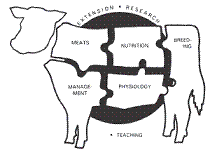Animal Science, Department of
Date of this Version
2024
Citation
2024 Nebraska Beef Cattle Report
UNL Beef, Institute of Agriculture and Natural Resources, University of Nebraska-Lincoln
Abstract
The study compared pregnancy rates of beef heifers artificially inseminated with multi-sire semen to single-sire semen at ranch 1 and demonstrated pregnancy to multi-sire sexed semen at rand 2. It was hypothesized pregnancy rates resulting from multi-sire semen would be increased compared to single-sire semen. Ranch 1 heifers were inseminated with either single-sire or multi-sire semen and all heifers expressing estrus at ranch 2 were inseminated with multi-sire semen averaged numerically greater pregnancy rate than the average single-sire pregnancy rate and pregnancy outcomes from multi-sire sexed semen exceed previous literature but cannot be directly compared. Despite similar pregnancy results between each single-sire treatment, paternity results suggest sires produce unequal proportions of offspring when their semen is mixed. In summary, producers looking to maximize pregnancy rate to artificial insemination may consider multi-sire insemination but more data is required.
Included in
Large or Food Animal and Equine Medicine Commons, Meat Science Commons, Veterinary Preventive Medicine, Epidemiology, and Public Health Commons

